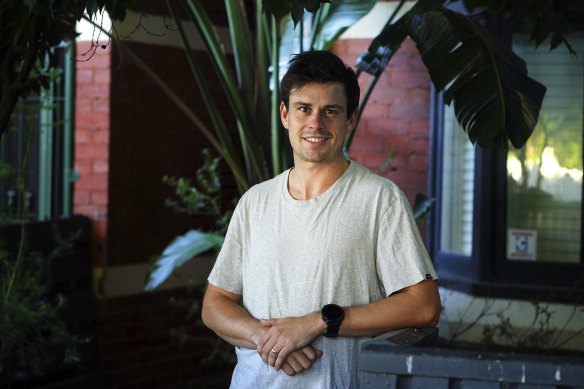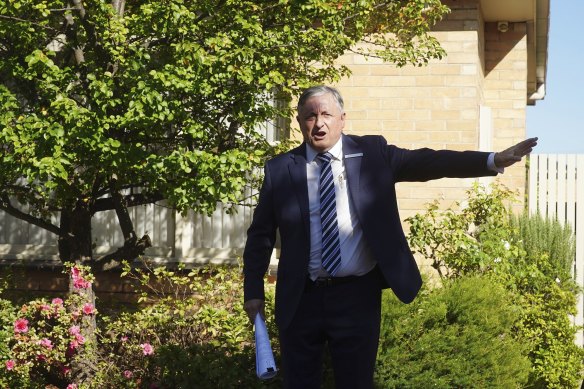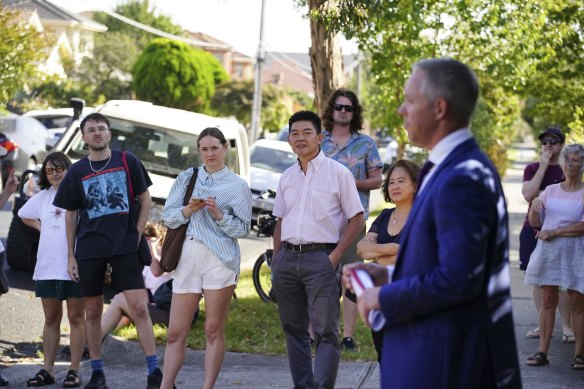This was published 4 months ago
Mitchell was trying to buy a home. Then $150,000 nearly evaporated
By Alexandra Middleton and Tawar Razaghi
Mitchell Raynes-Greenow was looking to buy his first home but as interest rates rose, he faced a budget cut of $150,000.
He’s not alone – rising interest rates over the past two years have left many hopeful home buyers with holes in their budgets.

Mitchell Raynes-Greenow and his wife were looking for 12 months before finding a property. Credit: Luis Ascui
But the Reserve Bank’s change in tone this week has raised hopes that rate rises could have finally come to an end, signalling some relief for borrowers.
Raynes-Greenow and his wife Nina Stephens were able to find a way to secure a loan and buy a house in St Kilda eventually, but not before rate rises threatened to reduce their borrowing power.
They began looking for their first home in early 2022. With a pay rise on the horizon, the couple held off making offers, hoping they could soon borrow more money.
But by the time the pay rise arrived, and they were ready to buy, interest rates had started going up and dented their hopes.
“We were looking for probably 12 months and during that time we were obviously stressed about it,” Raynes-Greenow told The Age.
“It was such a fine line between us really going for a house and then just holding off for a couple of months to try and get that pay increase,” he said.
“If we had waited for any longer, or I didn’t get that pay rise, it could have ended badly for us.”
The St Kilda couple secured a loan thanks to the help of a guarantor and managed to buy a house in December 2022.

Interest rate rises reduced home buyers’ budgets at auction. Credit: Luis Enrique Ascui
Raynes-Greenow said if their guarantor hadn’t pulled through and if he didn’t get a pay rise, they would have lost about $150,000 of their borrowing power.
“It was the difference between a three-bedroom and two-bedroom house,” he said.
When the cash rate was at its lowest in April 2022, a couple on average incomes could borrow up to $1,385,000.
Two years and 13 rate rises later, that figure has decreased by more than $400,000, leaving the same couple with a borrowing capacity of up to $952,000, according to modelling from comparison platform Canstar.
The median house value in Melbourne is about $943,000, while the median unit value is about $607,000, on CoreLogic data.
Senior mortgage broker at Axton Finance Luke Rowland said some buyers have been forced to explore other options to boost their borrowing power.
“We get on to borrowing capacities quite early in the conversation and if it’s not stacked up to what it needs to be, we have to find other solutions,” Rowland said.
“That might be getting parents involved or looking at other ways to try and boost deposits to cover that gap and serviceability – some people might need to just save up that little bit extra.”

Buyers have lost more than $400,000 borrowing capacity. Credit: Luis Ascui
Rowland said some buyers have no choice but to look outside their desired location in order to secure a larger home.
Chief economist at AMP Shane Oliver said interest rate hikes have slashed borrowing capacity for Australians earning an average income by nearly 30 per cent, forcing some buyers out of the housing market altogether.
“That’s quite a hefty reduction in how much a buyer can afford to pay for property,” Oliver said.
“You either have to get something smaller or, basically, you have to buy something cheaper – maybe settling for a unit rather than a house or a two-bedroom unit rather than a three-bedroom unit, or moving to a cheaper suburb – so it has had the effect of squeezing some buyers out of the property market.”
Oliver said he was optimistic about interest rates falling later this year, but warned there was a risk of that decision being delayed to 2025.
“If that’s the case, then it does put more of a cloud over the property market outlook for the simple reason that buyers will remain under pressure for longer or their capacity to borrow will be constrained for longer.”
Canstar’s group executive of financial services Steve Mickenbecker said rising mortgage repayments have exacerbated the difficulty of buying a home.
“When you looked back two years ago, before the RBA started putting rates up, the big barrier entering the property market was getting a deposit together, and with rates as low as they were still able to afford the mortgage, but that’s switched around,” Mickenbecker said.
“The deposit is still a big barrier to entry, but the affordability of repayments has knocked them about compared to two years ago.”
He said dual-income households already in the market have it slightly easier as they have built up equity, but they are still affected.